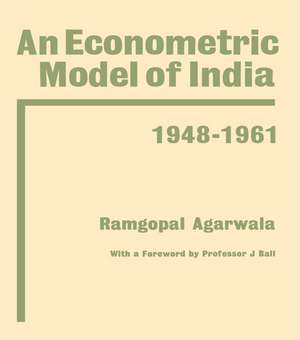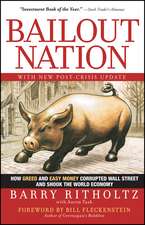Econometric Model of India
Autor Ramgopal Agarwalaen Limba Engleză Hardback – 19 iun 1970
Preț: 1051.55 lei
Preț vechi: 1282.39 lei
-18% Nou
Puncte Express: 1577
Preț estimativ în valută:
201.21€ • 219.25$ • 169.55£
201.21€ • 219.25$ • 169.55£
Carte tipărită la comandă
Livrare economică 23 aprilie-07 mai
Preluare comenzi: 021 569.72.76
Specificații
ISBN-13: 9780714612003
ISBN-10: 0714612006
Pagini: 204
Dimensiuni: 138 x 216 x 18 mm
Greutate: 0.36 kg
Ediția:1
Editura: Taylor & Francis
Colecția Routledge
Locul publicării:Oxford, United Kingdom
ISBN-10: 0714612006
Pagini: 204
Dimensiuni: 138 x 216 x 18 mm
Greutate: 0.36 kg
Ediția:1
Editura: Taylor & Francis
Colecția Routledge
Locul publicării:Oxford, United Kingdom
Cuprins
Part 1 Introduction: the macro-model; the data; the outline. Part 2 A theory of stagnation and growth: a macro-model in a closed economy; money in growth; growth and the foreign sector; the summary. Part 3 The statistical form of the model: production functions; employment functions; investment functions; money, wages and prices; miscellaneous equations; the model as a whole; method of estimation of the parameters of the model - ordinary least squares v. simultaneous equation methods. Part 4 Production and employment: agricultural production function; food-grains production function; employment function; non-agricultural production function. Part 5 Money, wages and prices: the money supply and the absolute price level; money wages and prices; miscellaneous price equations. Part 6 Investment and foreign trade: investment in the agricultural sector; investment in non-agricultural sector; foreign trade sector. Part 7 Summary of the results: the model; the test statistics; results of simultaneous equation methods. Part 8 Applications of the model - a simulation approach: a note on simulation approach; prediction within and beyond the sample; planning for a target rate of growth; analysis of the effects of variation in exogenous variables. Part 9 A note on India's third five year plan. Appendix - the compilation of the data.















